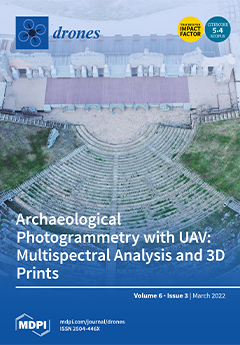This study explores the application of small, commercially available drones to determine morphometric the measurements and record key demographic parameters of reef manta rays (
Mobula alfredi) in Raja Ampat, Indonesia. DJI Mavic 2 Pro drones were used to obtain videos of
[...] Read more.
This study explores the application of small, commercially available drones to determine morphometric the measurements and record key demographic parameters of reef manta rays (
Mobula alfredi) in Raja Ampat, Indonesia. DJI Mavic 2 Pro drones were used to obtain videos of surface-feeding
M. alfredi with a floating, known-length PVC pipe as a reference scale—thus avoiding the need to utilize altitude readings, which are known to be unreliable in small drones, in our photogrammetry approach. Three dimensions (disc length (DL), disc width (DW), and cranial width (CW)) from 86 different individuals were measured. A hierarchical multivariate model was used to estimate the true measurements of these three dimensions and their population-level multivariate distributions. The estimated true measurements of these dimensions were highly accurate and precise, with the measurement of CW more accurate than that of DL and, especially, of DW. Each pairing of these dimensions exhibited strong linear relationships, with estimated correlation coefficients ranging from 0.98–0.99. Given these, our model allows us to accurately calculate DW (as the standard measure of body size for mobulid rays) using the more accurate CW and DL measurements. We estimate that the smallest mature
M. alfredi of each sex we measured were 274.8 cm (males,
n = 30) and 323.5 cm DW (females,
n = 8). We conclude that small drones are useful for providing an accurate “snapshot” of the size distribution of surface-feeding
M. alfredi aggregations and for determining the sex and maturity of larger individuals, all with minimal impact on this vulnerable species.
Full article





